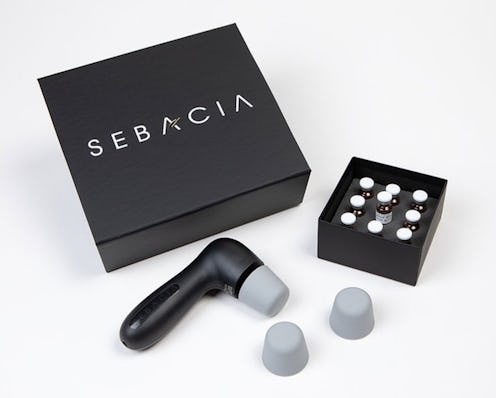(Beauty)
This New Acne Laser Works In Ways Other Treatments Can’t

Theoretically, curing acne seems so simple. Excess oil (also known as sebum) plays a huge part in the proliferation of acne — whether the skin creates too much oil on its own, hormone changes prompt extra sebum production, or pores get clogged with oil and bacteria — so it stands to reason that by eliminating oil, you eliminate most acne, right? This is dermatology’s constant struggle, and there are countless topical creams, antibiotics, and laser treatments on the market that attempt to do just that. But Sebacia Microparticles, the new FDA-approved acne treatment, aims to solve one of the biggest skincare qualms other treatments haven't been able to crack: Once you factor in user error (like skipping a day of antibiotics) and side effects (like dry, sensitive skin), quite a few at-home acne treatments don’t actually deliver completely blemish-free skin — especially not immediately.
“We've known for many years that heat reduces sebum production, meaning that if we could heat up and damage the oil producing glands in the skin, their ability to produce oil diminishes,” Dr. Ted Lain of Sanova Dermatology tells The Zoe Report, on behalf of medical device company Sebacia. “However, the glands are located deep within the pores, and using lasers alone to deliver energy to that area is both painful and potentially damaging.” Although laser technology has been utilized in the treatment of acne, it can only go so far; the heat required to effectively “damage” the sebaceous glands carries the risk of harming the skin in other ways, too.
Which is why Sebacia worked with Rice University researchers, led by Naomi Halas, PhD, and Duke University’s Jennifer West, PhD to develop a molecule that could help contain the energy of laser light within a concentrated area, and thus mitigate the risk of skin damage.
The microparticles that the Sebacia team created feature a silica core covered in gold. These materials — when broken down into really small pieces — have the ability to penetrate the skin and reach the sebaceous glands, located deep in the reticular layer of the dermis (in other words, not so easy to get to). Since gold is a light-absorbing material, it draws in the laser’s pulsing light and delivers it directly to the sebaceous gland.
“The microparticles efficiently absorb the laser energy, such that when they're located in or near the glands, the amount of laser energy required to heat the gland is much less than laser alone,” Dr. Lain explains. “This allows dermatologists to finally harness the beneficial effects of lasers for acne, while potentially avoiding the side effects.”
During treatment — which has to be performed in-office by a dermatologist — these microparticles are suspended in a thin, watery formula and massaged onto clean skin. Next, acne lesions are targeted with a pointed laser, effectively halting oil production in the gland underneath. To clarify, the treatment is best for mild to moderate inflammatory acne — pimples and pus bumps. Cystic acne is usually considered moderate to severe acne, and patients with cysts were not allowed to enroll in the trials, according to Sebacia.
A full round of treatment requires weekly sessions for three consecutive weeks. “Acne improves dramatically even after the first treatment,” Dr. Lain tells us. “What is more encouraging, however, is that the acne continues to improve for weeks to months after the last treatment.”
The clinical trials, performed both in the United States and Europe, are promising. In a controlled test of 168 patients, Sebacia Microparticles showed a “53 percent median reduction in inflammatory lesion count,” according to the study, as compared to a 45 percent reduction with the use of laser alone. (Those are basically fancy words for "pimples.") Additionally, 30.1 percent of the trial participants had clear or nearly clear skin after a full round of treatment. Sebacia notes that the control group was an active treatment (not a placebo) and furthermore, the study technically wasn't designed to show a difference between those groups on that measure. The important takeaway here, they say, is that a third of the patients had clear or almost clear skin in this controlled trial setting.
The fact that Sebacia Microparticles is FDA-approved means that the Food and Drug Administration has determined that the benefits of the process outweigh the risks — there are some concerns, though. The clinical trials focused only on participants with mild to moderate acne, so this isn’t a viable option for those with severe acne — yet. Studies focused on different forms of acne may be performed in the future.
“Any laser treatment has the risk of causing a burn or even scarring the skin,” Dr. Lain adds. “However, since the energy required to heat the Sebacia Microparticles is quite low, any burn that did occur during the trials was mild and resolved without scarring.”
On that note: “The treatment does require activation with a laser, so more caution might be required with darker skin types,” Dr. Sejal Shah of SmarterSkin Dermatology tells The Zoe Report, noting that high concentrations of melanin can make the skin more susceptible to laser damage. So far, Sebacia Microparticles has only tested the technology on “lighter-skinned acne patients,” per Dr. Lain. “Trials are planned for darker skin tones with possibly different laser settings,” he says. “Once these are published the treatment will likely be very safe for all skin tones.”
Sebacia Microparticles’ technology will be available to dermatologists in 2019, so check in with your doctor in the new year to see if the treatment is a good fit for you — and be sure to ask about pricing, as everyone's insurance is different. “As with any acne treatment, it may not be effective in everyone,” Dr Shah tells us. “But is a nice addition to our armamentarium against acne.”